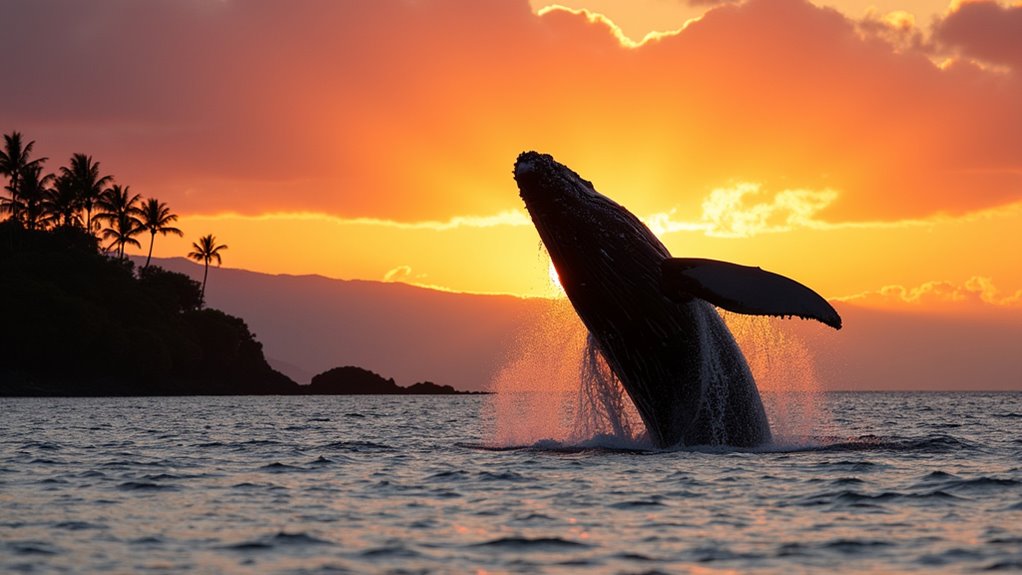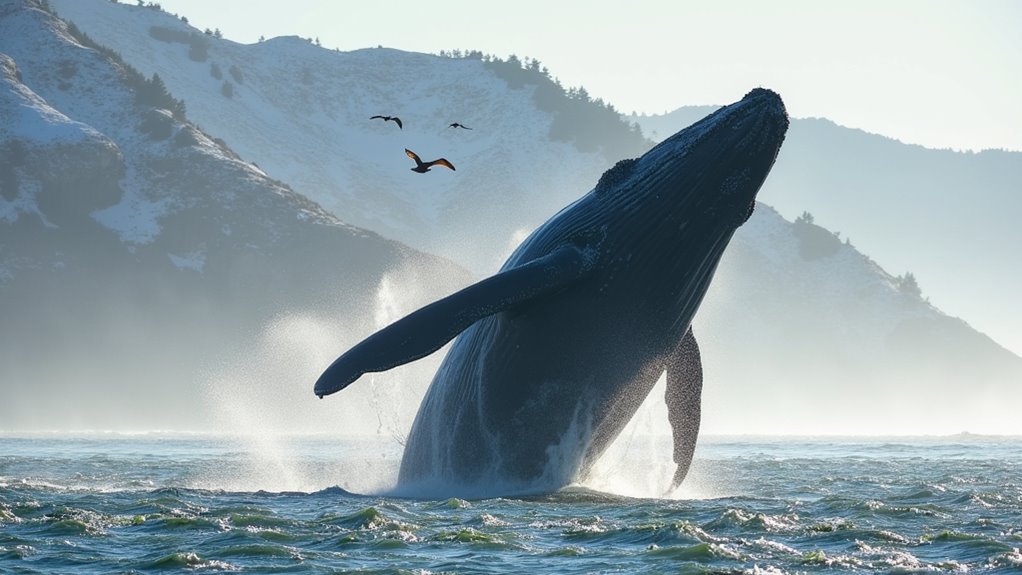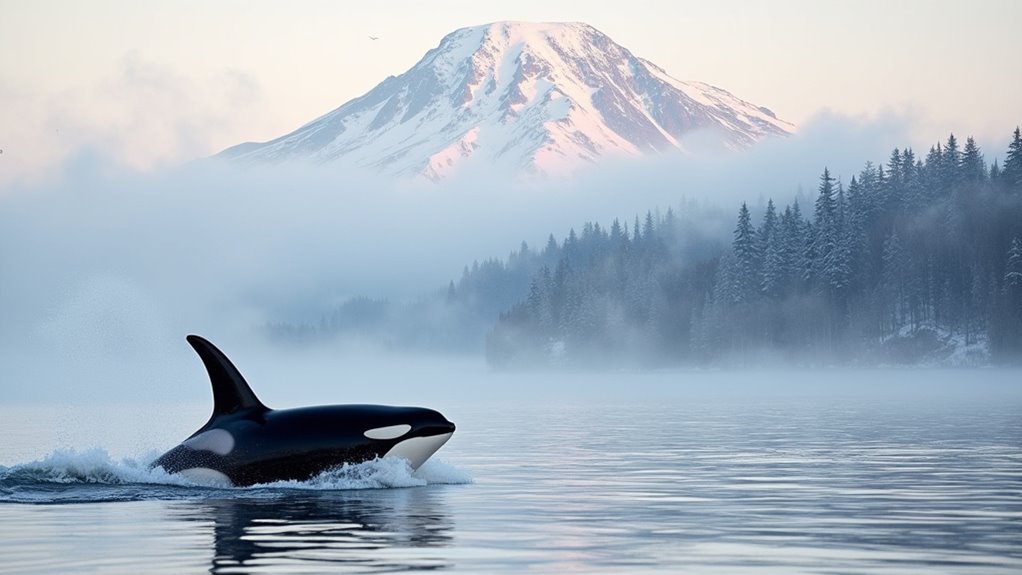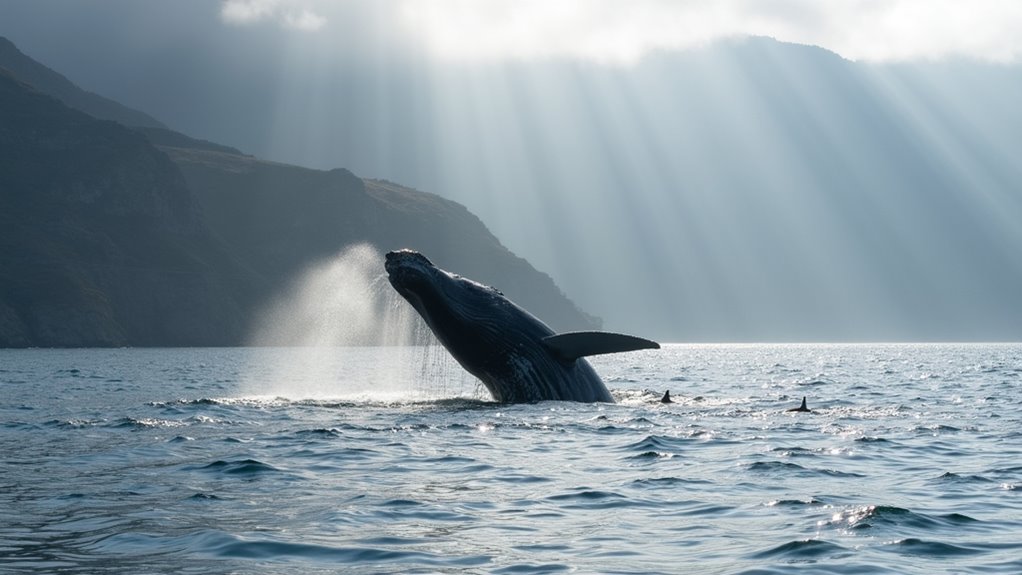Physical Address
304 North Cardinal St.
Dorchester Center, MA 02124
Physical Address
304 North Cardinal St.
Dorchester Center, MA 02124

Haunting whale songs and spectacular breaches await at America's top winter viewing spots, from Hawaii's warm seas to Alaska's icy waters.
You can spot majestic whales from sandy shores, rugged cliffs, or comfortable boat decks across America’s most spectacular winter viewing locations. While many travelers assume whale watching requires an expensive voyage, you’ll find that several of these destinations offer budget-friendly options and local cultural experiences. From Maui’s warm waters to Oregon’s misty coastline, each location provides its own unique perspective on these magnificent marine mammals. Let’s explore which destination might best suit your winter wildlife adventure.

When winter blankets the northern hemisphere, Maalaea Harbor transforms into one of Hawaii’s premier whale watching destinations. From December through April, you’ll witness North Pacific Humpbacks performing spectacular displays as they migrate from Alaska to breed and birth in Hawaii’s warm waters.
You’ll get the best value from January to March, when whale activity peaks. For about $67, you can join a two-hour narrated cruise departing from Maalaea’s strategic south shore location. These majestic creatures can remain submerged for 30 minutes while diving deep beneath the surface.
You’ll likely see mothers teaching calves, males competing for mates, and whales breaching, tail slapping, and singing. The harbor’s position between Molokai and Lanai offers prime viewing opportunities of these magnificent creatures.
Witness nature’s grandest spectacle as humpback whales breach, sing and nurture their young in Hawaii’s protected waters.
Don’t forget your camera and binoculars, and book early – tours fill quickly during peak season.
Along San Diego’s sun-drenched coast, one of nature’s most remarkable migrations unfolds as thousands of gray whales make their epic 12,000-mile round-trip journey from Arctic waters to Baja California.
You’ll find prime viewing opportunities from December through April, with January and February offering peak sightings. An estimated 20,000 gray whales travel this coastal route annually, making it one of the most reliable whale-watching destinations.
Experience this magnificent spectacle at these budget-friendly locations:
Don’t forget your binoculars to spot these gentle giants breaching and fluking just miles from shore.
For a closer encounter, local whale-watching tours operate throughout the season, though the area’s coastal canyons offer excellent land-based viewing without the expense of boat tours.

Nestled along California’s central coast, Monterey Bay serves as North America’s premier destination for winter whale watching, thanks to its unique submarine canyon that brings deep ocean waters close to shore.
You’ll witness one of Earth’s most spectacular migrations as over 20,000 gray whales journey past the bay between December and February. While gray whales steal the spotlight, you might also spot humpbacks, occasional blue whales, and resident orca pods that hunt in groups of 8-20.
Daily trips with experienced operators like Monterey Bay Whale Watch include expert naturalists who’ll help you identify various species. During peak season, visitors can observe unique behaviors like pec slapping and breaching among the humpback whales.
Beyond whales, you’ll encounter abundant marine life including dolphins, porpoises, and seabirds. The bay’s plentiful ecosystem and year-round accessibility make it an ideal choice for budget-conscious wildlife enthusiasts seeking a world-class whale watching experience.
Moving up the Pacific coast from Monterey Bay, Oregon’s charming coastal town of Depoe Bay serves as the state’s premier whale watching destination.
Home to the world’s smallest navigable harbor, this historic spot offers you exceptional whale viewing opportunities from both land and sea. You can spot whales during their northbound migration to Alaska from late March through May.
For the budget-conscious traveler, you’ll find several remarkable features:
You’ll want to arrive early morning before the winds pick up, when the ocean’s calm offers ideal viewing conditions. Cold-weather camping gear can be useful for staying comfortable during these early morning whale-watching excursions.
The center’s knowledgeable staff and volunteers enhance your experience with insights about whale behavior and conservation efforts, making Depoe Bay a must-visit destination for marine enthusiasts.

While gray whales dominate Oregon’s coastline, the San Juan Islands of Washington State offer you America’s premier destination for observing majestic orca pods in their natural habitat.
The islands host the famous Southern Resident killer whales, with tour operators reporting up to 90% sighting success rates during peak season.
Though summer months (June-September) provide ideal viewing conditions, you’ll find year-round opportunities to spot these magnificent creatures. Tours operate March through October, offering extensive opportunities to witness these marine mammals in action.
Summer brings peak whale watching, but these majestic marine mammals grace the San Juan Islands throughout all seasons.
Local tour operators work together through spotting networks to maximize your chances of encountering orcas, which can travel up to 100 miles daily.
You’ll benefit from choosing guided tours that include educational components about whale conservation and habitat protection.
The area’s robust whale-watching industry supports both the local economy and research organizations like the Center For Whale Research.
Alaska’s majestic Glacier Bay National Park transforms into a pristine winter wonderland, offering intrepid whale watchers a unique perspective on marine life against a backdrop of snow-draped mountains.
While winter visits require careful planning and specialized gear, you’ll find fewer crowds and opportunities to spot diverse wildlife in this UNESCO World Heritage site.
You won’t find many formal tours during winter months, but self-guided exploration from Glacier Bay Lodge can be rewarding.
Just pack proper cold-weather gear and consider booking a flightseeing tour for a breathtaking aerial view of this protected ecosystem.

Just five islands make up Southern California’s premier whale-watching destination, where you’ll find some of the world’s most spectacular marine life viewing opportunities.
From late December through mid-April, you can witness the majestic Gray Whale migration, with peak sightings between January and March. Professional tours like Channel Islands Expeditions offer daily 3.5-hour trips with guaranteed whale sightings. Camping can enhance mental well-being, which can make for a more enjoyable and relaxing whale-watching experience.
Experience nature’s grandest spectacle as Gray Whales make their annual journey past the Channel Islands from winter through early spring.
Departing from Channel Islands Harbor in Oxnard, tours typically run in the morning and won’t break your budget. If you don’t spot any whales during your trip, you’ll get a free return voyage.
While Gray Whales dominate the winter season, you’ll likely encounter year-round residents like Orcas, dolphins, sea lions, and seals.
The nutrient-rich waters of the Santa Barbara Channel create perfect feeding grounds, making this protected marine sanctuary an ideal spot for observing these magnificent creatures in their natural habitat.
Further south along California’s coast, Newport Beach serves as one of the Pacific’s premier whale watching destinations. Known as Orange County’s “Whale Highway,” this vibrant coastal community offers you incredible opportunities to witness marine life along major migration routes. Tours can be easily booked through their direct phone line at (949) 675-0551.
You’ll find peak whale watching during winter months when gray whales make their spectacular journey south. Local operators like Newport Landing and Davey’s Locker provide daily guided tours with expert narration, making this an educational and budget-friendly adventure.
Don’t worry if you miss peak season – Newport Beach’s affluent marine biodiversity guarantees memorable encounters throughout the year.
You’ll discover a million shades of wonder at these eight remarkable whale watching destinations across America. From Maui’s intimate mother-calf encounters to San Diego’s budget-friendly excursions, there’s a perfect spot for every traveler and wallet. Whether you’re chasing orcas in the San Juan Islands or spotting gray whales along Newport’s bustling Whale Highway, these locations offer unforgettable cultural and natural experiences without breaking the bank.